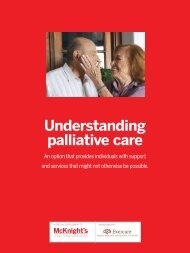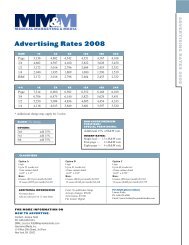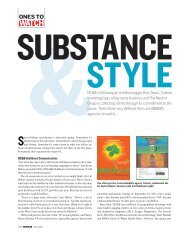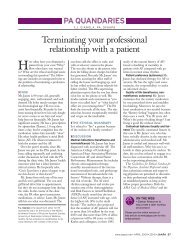Review - Haymarket Media Group
Review - Haymarket Media Group
Review - Haymarket Media Group
Create successful ePaper yourself
Turn your PDF publications into a flip-book with our unique Google optimized e-Paper software.
hand-foot syndrome, 23.9% vs 31.1%; and cardiac, 2.9% vs<br />
4.9%. There were no therapy-related deaths.<br />
The preliminary results of this TBP study suggest similar<br />
toxicity but higher efficacy for continuing trastuzumab<br />
beyond progression when second-line chemotherapy with<br />
capecitabine is initiated. The final efficacy analysis was<br />
scheduled to be released at a later date.<br />
Von Minckwitz G, et al. J Clin Oncol. 2008;26(May 20 suppl). Abstract 1025.<br />
Anastrozole Plus Gefitinib Compared With<br />
Anastrozole Plus Placebo in Postmenopausal<br />
Women With Hormone Receptor–Positive<br />
Metastatic Breast Cancer<br />
Preclinical data indicate the presence of crosstalk between<br />
growth factor receptor pathways and the estrogen receptor.<br />
Thus, a technique to overcome hormonal resistance<br />
might involve inhibition of both epidermal growth factor<br />
receptor and estrogen receptor signaling. This phase II<br />
multicenter, double-blind, randomized trial was designed<br />
to evaluate the efficacy and tolerability of anastrozole<br />
plus gefitinib vs anastrozole plus placebo in postmenopausal<br />
women with newly diagnosed hormone<br />
receptor–positive metastatic breast cancer.<br />
Ninety-four patients were randomized to receive anastrozole<br />
1 mg/day plus either gefitinib 250 mg/day or<br />
placebo (50 women received anastrozole plus placebo; 43<br />
received anastrozole plus gefitinib; one died prior to<br />
treatment). PFS was the primary end point. The secondary<br />
end points included objective response rate, clinical<br />
benefit rate (defined as objective response or stable disease<br />
≥24 weeks), overall survival, safety, and tolerability.<br />
Enrollment was stopped early because of slow<br />
recruitment, and fewer statistical analyses were performed.<br />
However, a marked advantage in PFS was seen<br />
for anastrozole plus gefitinib over anastrozole plus<br />
placebo (median 14.5 vs 8.2 months). Complete response<br />
was noted in 1 patient in each group. A numerical<br />
advantage in clinical benefit rate was seen for anastrozole<br />
plus gefitinib (21 patients, 49%) vs anastrozole plus<br />
placebo (17 patients, 34%). There were no unexpected<br />
safety or tolerability findings. Treatment-related adverse<br />
events, mostly mild, were seen in 79% of patients in the<br />
anastrozole plus gefitinib arm vs 38% in the anastrozole<br />
plus placebo arm. Death occurred in 2 patients in the<br />
anastrozole plus gefitinib arm and 1 patient in the anastrozole<br />
plus placebo arm; none were considered related<br />
to treatment.<br />
The authors concluded that anastrozole plus gefitinib<br />
was well tolerated and showed a marked advantage in<br />
PFS when compared with anastrozole plus placebo in<br />
postmenopausal women with newly diagnosed hormone<br />
receptor–positive metastatic breast cancer. They also reported<br />
that the data suggest the need for further investigation<br />
of this combination.<br />
Cristofanilli M, et al. J Clin Oncol. 2008;26(May 20 suppl). Abstract 1012.<br />
Lapatinib Alone or in Combination With<br />
Trastuzumab in Heavily Pretreated HER2+<br />
Metastatic Breast Cancer That Progressed on<br />
Trastuzumab Therapy<br />
Preclinical data indicate possible synergy between<br />
trastuzumab and lapatinib, an oral, small-molecule<br />
inhibitor of EGFR and HER2 with a mechanism of action<br />
distinct from that of trastuzumab. In this randomized<br />
phase III study, researchers evaluated lapatinib alone and<br />
in combination with trastuzumab in women with HER2+<br />
metastatic breast cancer who had experienced progressive<br />
disease while on trastuzumab therapy.<br />
Women with these characteristics were eligible for participation<br />
if they had also received prior anthracycline and<br />
taxane therapy and had measurable lesions or bone-only<br />
disease. Patients were first stratified according to hormone<br />
receptor status and the presence of visceral or nonvisceral<br />
disease, then randomized to receive either lapatinib (1500<br />
mg qd) or lapatinib (1000 mg qd) plus trastuzumab (2<br />
mg/kg weekly after a 4 mg/kg loading dose). The primary<br />
end point was PFS (determined by investigator assessment);<br />
secondary end points were clinical benefit rate at 24<br />
weeks, response rate, and overall survival. Patients who<br />
progressed while taking lapatinib were allowed to cross<br />
over to the lapatinib plus trastuzumab arm.<br />
Of the 296 patients who were randomized, all had<br />
received prior trastuzumab therapy and a median of 6 prior<br />
chemotherapy regimens. The addition of trastuzumab to<br />
lapatinib significantly improved PFS (median 8.4 weeks for<br />
lapatinib vs 12.0 weeks for lapatinib plus trastuzumab;<br />
P=0.029) and clinical benefit rate (13.2% for lapatinib vs<br />
25.2% for lapatinib plus trastuzumab; P=0.020). Response<br />
rate and overall survival were similar in the two arms.<br />
In general, both treatment arms were well tolerated.<br />
Grade 1/2 diarrhea was higher in the lapatinib plus<br />
trastuzumab arm (53% vs 41%); acneiform rash was more<br />
common in the lapatinib alone arm and was likely caused by<br />
the higher lapatinib dose. An asymptomatic decline in LVEF<br />
(>20%, and below LLN) occurred in 5% of the patients in the<br />
combination arm and in 2% of patients in the lapatinib<br />
alone arm. One patient in the lapatinib plus trastuzumab<br />
arm died; death was attributed to cardiac toxicity.<br />
This is the largest study of two targeted agents in<br />
HER2+ metastatic breast cancer and the first to demonstrate<br />
the synergy of lapatinib plus trastuzumab in a phase<br />
III trial. The authors concluded that the combination of<br />
lapatinib plus trastuzumab in patients progressing on<br />
trastuzumab-based therapy improved clinical outcome<br />
without major changes in the side effect profile. The<br />
authors also referred to the ongoing ALTTO (Adjuvant<br />
Lapatinib and/or Trastuzumab Treatment Optimization)<br />
study, in which the role of combined anti-HER2 therapy<br />
plus chemotherapy is being studied in less heavily pretreated<br />
patients with early-stage disease.<br />
O’Shaughnessy J, et al. J Clin Oncol. 2008;26(May 20 suppl). Abstract 1015.<br />
November 2008 • Vol 7 • Supplement 5 9
















